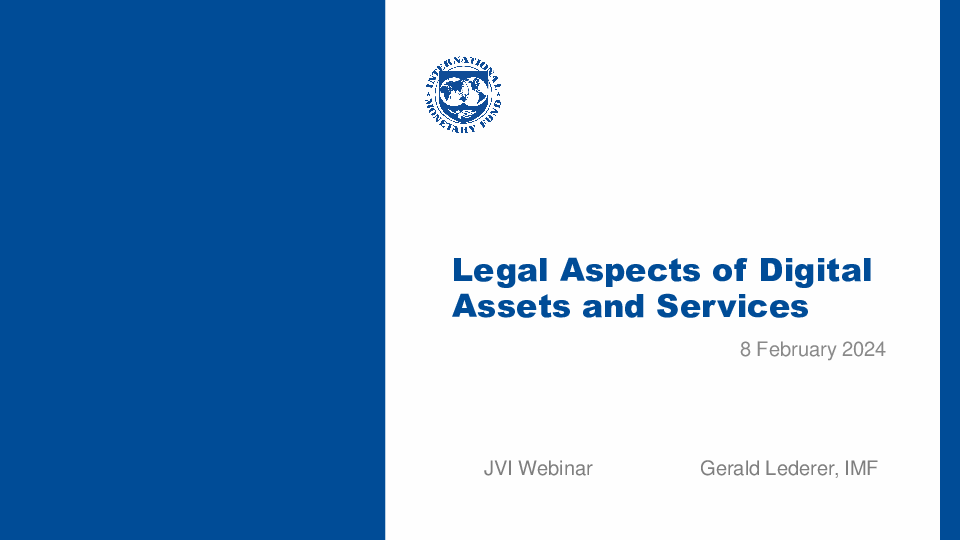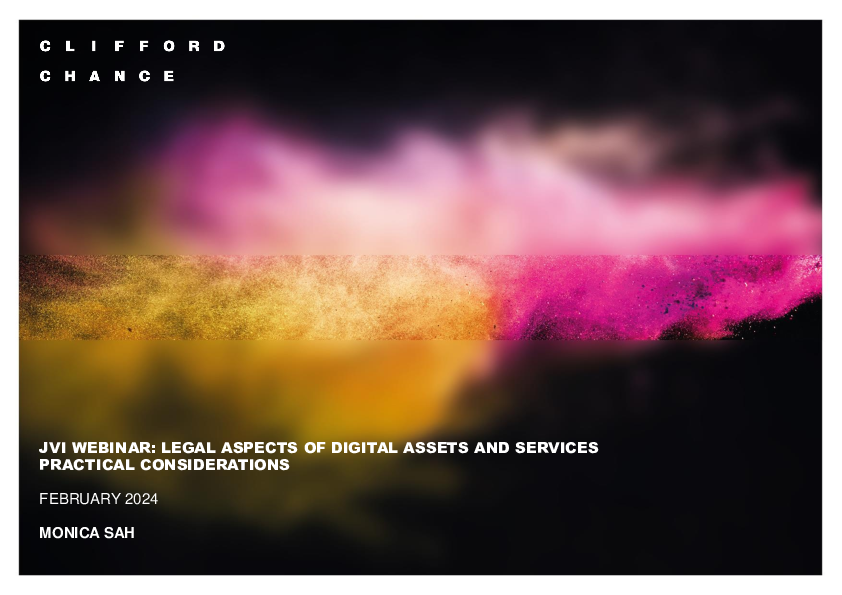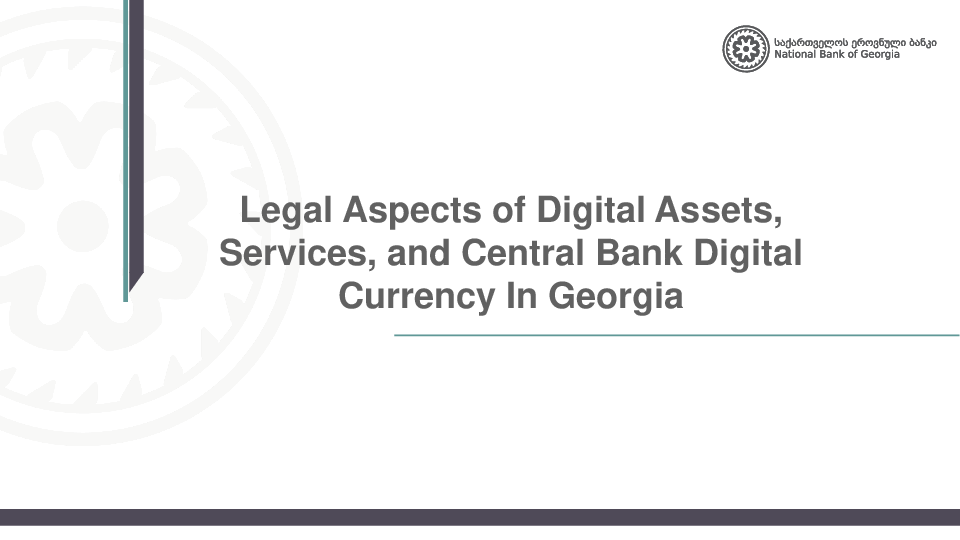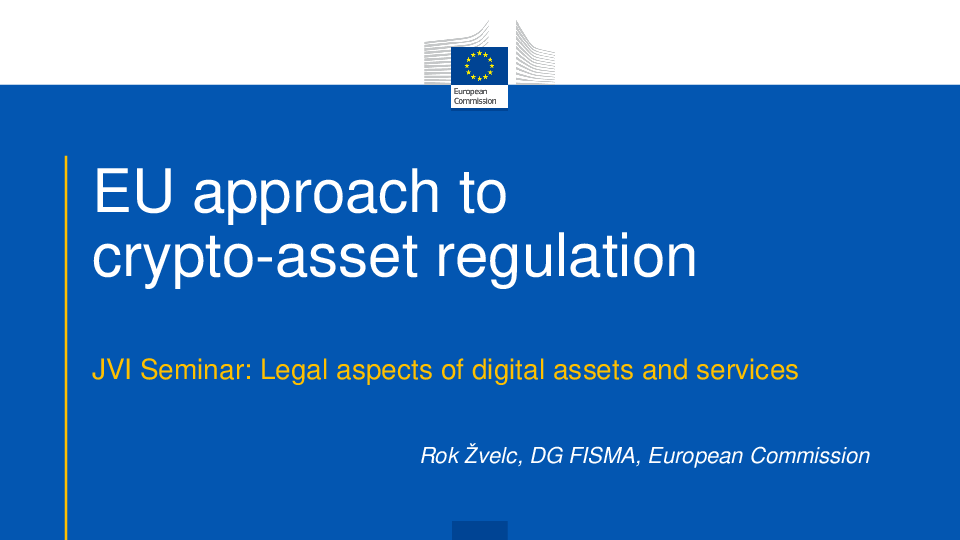Legal Aspects of Digital Assets and Services
Thursday, February 8, 2024, at 14:00-16:00 Vienna time (CET)
Moderators
Yan Liu, Deputy General Counsel, Legal Department, IMF
Alessandro Gullo, Assistant General Counsel, Legal Department, IMF
Discussants
Monica Sah, Partner, Clifford Chance
Rok Žvelc, Legal Officer at DG FISMA, European Commission
Papuna Papuashvili, Senior Lawyer, National Bank of Georgia
Gerald Lederer, Legal Counsel, IMF
The JVI hosted a webinar on February 8, 2024, focusing on legal aspects of digital assets and the provision of services related thereto, including legal aspects of Central Bank Digital Currencies (CBDC). This webinar highlighted key legal and regulatory challenges in dealing with digital assets, which continue to evolve as an asset-class in the financial sector. The webinar gave two practical examples of jurisdictional approaches to regulating the crypto-sector and also entailed key implementation and practical challenges from the view of a private sector legal practitioner.
Gerald Lederer, Legal Counsel at the IMF’s Legal Department, kicked off by highlighting some of the main legal challenges arising from digital assets. He focused his intervention on the difficulties of classifying different types of assets, which would however constitute a necessary prerequisite of a risk-based legal and regulatory framework that adheres to the principle of same activity, same risk, same regulation. Furthermore, he elaborated on important legal design questions that would need to be taken into account when putting in place a regulatory regime for crypto-assets. These questions range from the benefits and drawbacks of so called bespoke – i.e. new and comprehensive – frameworks vis-à-vis applying existing rules, to questions related to regulatory and supervisory rulemaking and discretion. In this regard, Gerald also touched upon the need to reflect on private law issues related to tokenization, as those would need to inform regulatory approaches to protect investors and financial stability. He then focused on the need to integrate regimes for private crypto-assets into the broader framework of payments and monetary laws of countries as a means to ensure the singleness of money by preserving legal tender status for publicly issued CBDC. He concluded his remarks by reiterating the importance of legal certainty and coherence as a prerequisite of proper regulation, and by explaining that in turn a solid legal framework will have positive effects on market practices, by fostering convergence, stability and trust.
Rok Žvelc, Legal Officer at DG FISMA, European Commission, continued with the first set of a regional example: the EU’s rules on markets in crypto-assets (Markets in Crypto-Assets Regulation, MiCAR) as well as the ongoing legislative deliberations on the Digital Euro. Rok opened by explaining the classification system put in place by MiCAR, i.e. a differentiation between so called asset-referenced tokens (ARTs), e-money tokens (EMTs) and other crypto assets that would not fall into those categories, but would also not constitute other regulated instruments as per other sectorial regulation (notably, he elaborated on the need to distinguish such crypto assets from financial instruments that are already regulated under existing traditional financial services laws). He then went on to explain key substantive obligations in relation to these types of assets, arguing that the heightened risks posed by ARTs and EMTs lead to more stringent regulation, both from the angle of financial stability and monetary policy transmission. Rok then touched upon the regulation of crypto-asset service providers which are subject to a string of obligations, including licensing, governance and other requirements. Moreover, MiCAR puts in place market integrity rules to avoid market abuse. Lastly, Rok shared initial views on the legislative discussion on the Digital Euro, explaining some of the key design features as proposed by the European Commission: the Digital Euro would constitute a direct liability of the central banks, be granted legal tender status, is not intended to be used as a store of value and hence holding limits will be put in place. Since the legal negotiations are ongoing, there is still a potential that the situation changes.
Papuna Papuashvili, Senior Lawyer, National Bank of Georgia, gave an overview of the National Bank of Georgia’s activities related to regulating digital asset service providers as well as in relation to their CBDC – the so-called digital GEL. Papuna first explained that Georgia was one of the first countries to put in place a crypto framework, not only in the region but globally. The focus was on requiring digital asset service providers to obtain licenses and be subject to certain regulatory requirements. Importantly, Papuna highlighted that virtual assets would not constitute a legal means of payment in Georgia. He then went on to explaining that next to registration and compliance obligations, also anti-money laundering concerns were sought to be addressed by the legislation, which was particularly achieved by implementing a travel-rule (i.e., ensuring that any transfer of crypto-assets should include certain information about the transferer and the receiver). On CBDC, Papuna highlighted that the work commenced early and was still in a testing phase. Legally, while the National Bank of Georgia is entitled to testing, the actual issuance of a CBDC would be prohibited absent legislative change in the Central Bank’s mandate (and other pieces of legislation). To conclude, Papuna stressed the need to maintain an open spirit since both the regulation of digital assets and services, as well as the issuance of CBDC would be entirely new projects. Hence, a certain degree of “learning by doing” would be unavoidable.
Lastly, Monica Sah, Partner, Clifford Chance, gave some first-hand insights from a legal practitioner’s perspective in advising the private sector in the field of digital finance. Monica too kicked off by highlighting the importance of the classification of assets, as this classification would determine whether a given project of one of her clients would fall within a regulated activity. This determination is difficult, especially in cross-border circumstances since the classification might differ from jurisdiction to jurisdiction. This, in turn, means that a separate assessment would have to be carried out for all potential jurisdictions. Monica exemplified the complexities of this approach using two practical cases: a crypto-exchange and a Bitcoin ETF/ETN. She then went on to a more granular discussion of classifying both digital assets and digital services under EU and UK rules, respectively (which would show some convergence, but also important discrepancies). Monica then turned to CBDCs and pointed out key legal issues ranging from CDBD characteristics and design choices to the issuance (would Central Banks have sufficient powers and mandates?) and access regime (e.g., via private banks?). Moreover, AML and data privacy aspects would need to be borne in mind. Legal solutions would likely require legal changes to Central Bank, Payment, Banking, Consumer and Data Laws. Monica wrapped up by stressing that the need for legislative change would also entail some difficulties owing to, for example, to lengthiness and inflexibility of parliamentary processes. On the other hand, only parliamentary laws would in many instances instill enough legal certainty for Central Banks and users of CBDC.
The Q&A session centered on the following main issues:
Firstly, the discussion focused on legal definitions and the need to ensure technological neutrality in regulating crypto assets. Here, panelists highlighted that while technological neutrality was important, it would be equally necessary to address new risks arising from the use of a given technology. It was also held that from the perspective of legal classification, the technology used is sometimes not the decisive factor: rather, the economic and legal functions performed are. In that sense, definitions could be drafted in a broader manner to ensure that legal concepts are applicable to different technological solutions, as long as the regulated activity would be captured under a definition.
The discussion then went on to investigate some more detailed questions relating to the EU framework, particularly on the different requirements when asset referenced tokens or e-money tokens are issued by banks and non-banks, and its interactions with other EU pieces of legislation. Moreover, the difficulties of banks providing services to crypto firms, especially in providing custody services, were discussed.
Lastly, there was a discussion around the possibilities of banks issuing stablecoins. Here, panelists agreed that there might be an argument that banks, as heavily regulated entities, would be capable of issuing stablecoins subject to their compliance with all regulations. However, the speakers were also cognizant of the fact that engaging in crypto-asset and stablecoin services next to their traditional banking activities will expose them to additional risks. Here, one panelist suggested that there could be a case for emergency powers of supervisors by equipping them with segregation powers in case of the build-up of significant risks (which is in line with some international guidance on the matter).
Gerald Lederer, Legal Counsel, IMF













